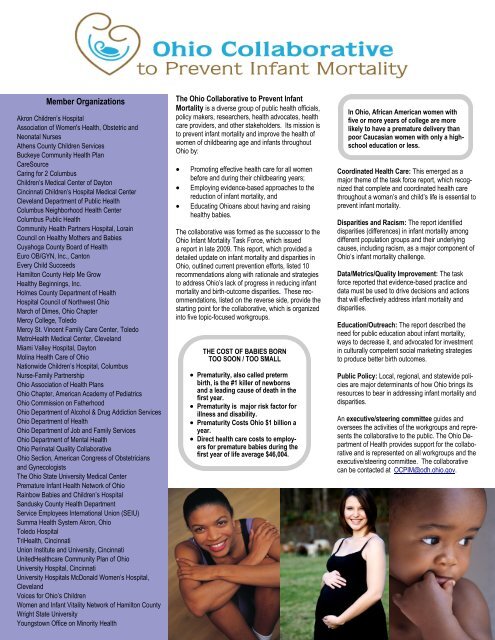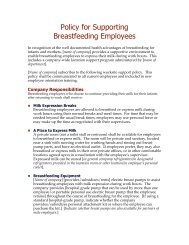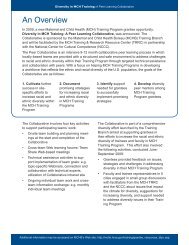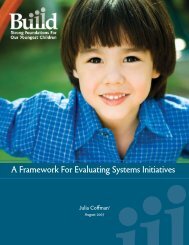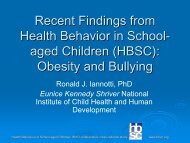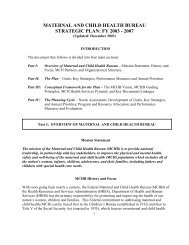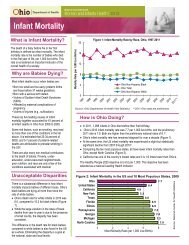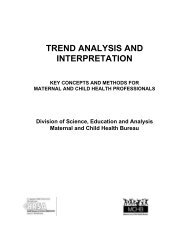Ohio Collaborative to Prevent Infant Mortality - Maternal and Child ...
Ohio Collaborative to Prevent Infant Mortality - Maternal and Child ...
Ohio Collaborative to Prevent Infant Mortality - Maternal and Child ...
You also want an ePaper? Increase the reach of your titles
YUMPU automatically turns print PDFs into web optimized ePapers that Google loves.
Member Organizations<br />
Akron <strong>Child</strong>ren’s Hospital<br />
Association of Women's Health, Obstetric <strong>and</strong><br />
Neonatal Nurses<br />
Athens County <strong>Child</strong>ren Services<br />
Buckeye Community Health Plan<br />
CareSource<br />
Caring for 2 Columbus<br />
<strong>Child</strong>ren’s Medical Center of Day<strong>to</strong>n<br />
Cincinnati <strong>Child</strong>ren’s Hospital Medical Center<br />
Clevel<strong>and</strong> Department of Public Health<br />
Columbus Neighborhood Health Center<br />
Columbus Public Health<br />
Community Health Partners Hospital, Lorain<br />
Council on Healthy Mothers <strong>and</strong> Babies<br />
Cuyahoga County Board of Health<br />
Euro OB/GYN, Inc., Can<strong>to</strong>n<br />
Every <strong>Child</strong> Succeeds<br />
Hamil<strong>to</strong>n County Help Me Grow<br />
Healthy Beginnings, Inc.<br />
Holmes County Department of Health<br />
Hospital Council of Northwest <strong>Ohio</strong><br />
March of Dimes, <strong>Ohio</strong> Chapter<br />
Mercy College, Toledo<br />
Mercy St. Vincent Family Care Center, Toledo<br />
MetroHealth Medical Center, Clevel<strong>and</strong><br />
Miami Valley Hospital, Day<strong>to</strong>n<br />
Molina Health Care of <strong>Ohio</strong><br />
Nationwide <strong>Child</strong>ren’s Hospital, Columbus<br />
Nurse-Family Partnership<br />
<strong>Ohio</strong> Association of Health Plans<br />
<strong>Ohio</strong> Chapter, American Academy of Pediatrics<br />
<strong>Ohio</strong> Commission on Fatherhood<br />
<strong>Ohio</strong> Department of Alcohol & Drug Addiction Services<br />
<strong>Ohio</strong> Department of Health<br />
<strong>Ohio</strong> Department of Job <strong>and</strong> Family Services<br />
<strong>Ohio</strong> Department of Mental Health<br />
<strong>Ohio</strong> Perinatal Quality <strong>Collaborative</strong><br />
<strong>Ohio</strong> Section, American Congress of Obstetricians<br />
<strong>and</strong> Gynecologists<br />
The <strong>Ohio</strong> State University Medical Center<br />
Premature <strong>Infant</strong> Health Network of <strong>Ohio</strong><br />
Rainbow Babies <strong>and</strong> <strong>Child</strong>ren’s Hospital<br />
S<strong>and</strong>usky County Health Department<br />
Service Employees International Union (SEIU)<br />
Summa Health System Akron, <strong>Ohio</strong><br />
Toledo Hospital<br />
TriHealth, Cincinnati<br />
Union Institute <strong>and</strong> University, Cincinnati<br />
UnitedHealthcare Community Plan of <strong>Ohio</strong><br />
University Hospital, Cincinnati<br />
University Hospitals McDonald Women’s Hospital,<br />
Clevel<strong>and</strong><br />
Voices for <strong>Ohio</strong>’s <strong>Child</strong>ren<br />
Women <strong>and</strong> <strong>Infant</strong> Vitality Network of Hamil<strong>to</strong>n County<br />
Wright State University<br />
Youngs<strong>to</strong>wn Office on Minority Health<br />
The <strong>Ohio</strong> <strong>Collaborative</strong> <strong>to</strong> <strong>Prevent</strong> <strong>Infant</strong><br />
<strong>Mortality</strong> is a diverse group of public health officials,<br />
policy makers, researchers, health advocates, health<br />
care providers, <strong>and</strong> other stakeholders. Its mission is<br />
<strong>to</strong> prevent infant mortality <strong>and</strong> improve the health of<br />
women of childbearing age <strong>and</strong> infants throughout<br />
<strong>Ohio</strong> by:<br />
<br />
<br />
<br />
Promoting effective health care for all women<br />
before <strong>and</strong> during their childbearing years;<br />
Employing evidence-based approaches <strong>to</strong> the<br />
reduction of infant mortality, <strong>and</strong><br />
Educating <strong>Ohio</strong>ans about having <strong>and</strong> raising<br />
healthy babies.<br />
The collaborative was formed as the successor <strong>to</strong> the<br />
<strong>Ohio</strong> <strong>Infant</strong> <strong>Mortality</strong> Task Force, which issued<br />
a report in late 2009. This report, which provided a<br />
detailed update on infant mortality <strong>and</strong> disparities in<br />
<strong>Ohio</strong>, outlined current prevention efforts, listed 10<br />
recommendations along with rationale <strong>and</strong> strategies<br />
<strong>to</strong> address <strong>Ohio</strong>’s lack of progress in reducing infant<br />
mortality <strong>and</strong> birth-outcome disparities. These recommendations,<br />
listed on the reverse side, provide the<br />
starting point for the collaborative, which is organized<br />
in<strong>to</strong> five <strong>to</strong>pic-focused workgroups.<br />
THE COST OF BABIES BORN<br />
TOO SOON / TOO SMALL<br />
Prematurity, also called preterm<br />
birth, is the #1 killer of newborns<br />
<strong>and</strong> a leading cause of death in the<br />
first year.<br />
Prematurity is major risk fac<strong>to</strong>r for<br />
illness <strong>and</strong> disability.<br />
Prematurity Costs <strong>Ohio</strong> $1 billion a<br />
year.<br />
Direct health care costs <strong>to</strong> employers<br />
for premature babies during the<br />
first year of life average $46,004.<br />
In <strong>Ohio</strong>, African American women with<br />
five or more years of college are more<br />
likely <strong>to</strong> have a premature delivery than<br />
poor Caucasian women with only a highschool<br />
education or less.<br />
Coordinated Health Care: This emerged as a<br />
major theme of the task force report, which recognized<br />
that complete <strong>and</strong> coordinated health care<br />
throughout a woman’s <strong>and</strong> child’s life is essential <strong>to</strong><br />
prevent infant mortality.<br />
Disparities <strong>and</strong> Racism: The report identified<br />
disparities (differences) in infant mortality among<br />
different population groups <strong>and</strong> their underlying<br />
causes, including racism, as a major component of<br />
<strong>Ohio</strong>’s infant mortality challenge.<br />
Data/Metrics/Quality Improvement: The task<br />
force reported that evidence-based practice <strong>and</strong><br />
data must be used <strong>to</strong> drive decisions <strong>and</strong> actions<br />
that will effectively address infant mortality <strong>and</strong><br />
disparities.<br />
Education/Outreach: The report described the<br />
need for public education about infant mortality,<br />
ways <strong>to</strong> decrease it, <strong>and</strong> advocated for investment<br />
in culturally competent social marketing strategies<br />
<strong>to</strong> produce better birth outcomes.<br />
Public Policy: Local, regional, <strong>and</strong> statewide policies<br />
are major determinants of how <strong>Ohio</strong> brings its<br />
resources <strong>to</strong> bear in addressing infant mortality <strong>and</strong><br />
disparities.<br />
An executive/steering committee guides <strong>and</strong><br />
oversees the activities of the workgroups <strong>and</strong> represents<br />
the collaborative <strong>to</strong> the public. The <strong>Ohio</strong> Department<br />
of Health provides support for the collaborative<br />
<strong>and</strong> is represented on all workgroups <strong>and</strong> the<br />
executive/steering committee. The collaborative<br />
can be contacted at OCPIM@odh.ohio.gov.
RECOMMENDATIONS TO PREVENT INFANT MORTALITY<br />
OHIO FACTS<br />
1,068 <strong>Ohio</strong> infants died in<br />
2010.<br />
<strong>Ohio</strong>’s infant mortality (IM)<br />
rate exceeds both the national<br />
rate of 6.14 per 1,000 live<br />
births <strong>and</strong> the Healthy People<br />
2010 (national public heath<br />
goal) of 4.5.<br />
Disparities (differences) between<br />
whites <strong>and</strong> African<br />
Americans are growing: the<br />
2010 IM rate for whites is 6.4<br />
<strong>and</strong> for African Americans it<br />
is 15.5.<br />
<strong>Ohio</strong>’s overall IM rate of 7.7<br />
has not substantially<br />
changed in more than a decade.<br />
The Medicaid program, serving<br />
our lowest-income citizens,<br />
pays for 40% of <strong>Ohio</strong>’s<br />
births <strong>and</strong> bears a heavy cost<br />
burden of poor birth outcomes.<br />
The infant mortality (death) rate: an<br />
important measure of how well we care for<br />
our women <strong>and</strong> children <strong>and</strong> the overall<br />
health of our society. This rate is calculated<br />
as the number of live-born infants per<br />
thous<strong>and</strong> who die within their first year of<br />
life. The United States has one of the<br />
highest rates among developed nations,<br />
<strong>and</strong> <strong>Ohio</strong>’s infant mortality rate exceeds<br />
that of the nation.<br />
Recommendation I: Provide comprehensive<br />
reproductive health services <strong>and</strong> service<br />
coordination for all women <strong>and</strong> children<br />
before, during <strong>and</strong> after pregnancy.<br />
Recommendation II: Eliminate health<br />
disparities <strong>and</strong> promote health equity <strong>to</strong><br />
reduce infant mortality.<br />
Recommendation III: Prioritize <strong>and</strong> align<br />
program investments based on documented<br />
outcome <strong>and</strong> cost effectiveness.<br />
Recommendation IV: Implement health<br />
promotion <strong>and</strong> education <strong>to</strong> reduce preterm<br />
birth.<br />
Recommendation V: Improve data collection<br />
<strong>and</strong> analysis <strong>to</strong> inform program<br />
<strong>and</strong> policy decisions.<br />
Recommendation VI: Exp<strong>and</strong> quality<br />
improvement initiatives <strong>to</strong> make measurable<br />
improvements in maternal <strong>and</strong> child<br />
health outcomes.<br />
Recommendation VII: Address the effects<br />
of <strong>and</strong> the impact of racism on infant<br />
mortality.<br />
Recommendation VIII: Increase public<br />
awareness on the effect of preconception<br />
health on birth outcomes.<br />
Recommendation IX: Develop, recruit<br />
<strong>and</strong> train a diverse network of culturally<br />
competent health professionals statewide.<br />
Recommendation X: Establish a consortium<br />
<strong>to</strong> implement <strong>and</strong> moni<strong>to</strong>r the recommendations<br />
of the <strong>Ohio</strong> <strong>Infant</strong> <strong>Mortality</strong><br />
Task Force (OIMTF).<br />
CALL TO ACTION: IF YOU ARE AN OHIOAN<br />
Make sure you/your partner are as healthy as possible<br />
before becoming pregnant.<br />
Encourage friends <strong>and</strong> family members who are of<br />
childbearing age <strong>to</strong> be as healthy as possible before becoming<br />
pregnant.<br />
Volunteer <strong>and</strong> support your local hospital, health department,<br />
faith community or community services agencies in<br />
their efforts <strong>to</strong> improve women’s health <strong>and</strong> promote better<br />
birth outcomes.<br />
Support your friends <strong>and</strong> family members who recently<br />
had a baby by encouraging safe sleeping position <strong>and</strong><br />
breastfeeding <strong>and</strong> helping them get <strong>to</strong> follow-up appointments.<br />
“<strong>Infant</strong> deaths are at the heart of<br />
our inadequate health care system.<br />
Why should any infant die<br />
because their mother had no<br />
health insurance before she became<br />
pregnant, had little access<br />
<strong>to</strong> treat anemia, depression, asthma,<br />
diabetes, or hypertension, or<br />
<strong>to</strong> safely space her last pregnancy?<br />
<strong>Infant</strong> deaths are preventable,<br />
if we realign our priorities <strong>and</strong><br />
our financial incentives.”<br />
-Patricia Temple Gabbe, MD, MPH<br />
<strong>Collaborative</strong> Member<br />
March 2012


